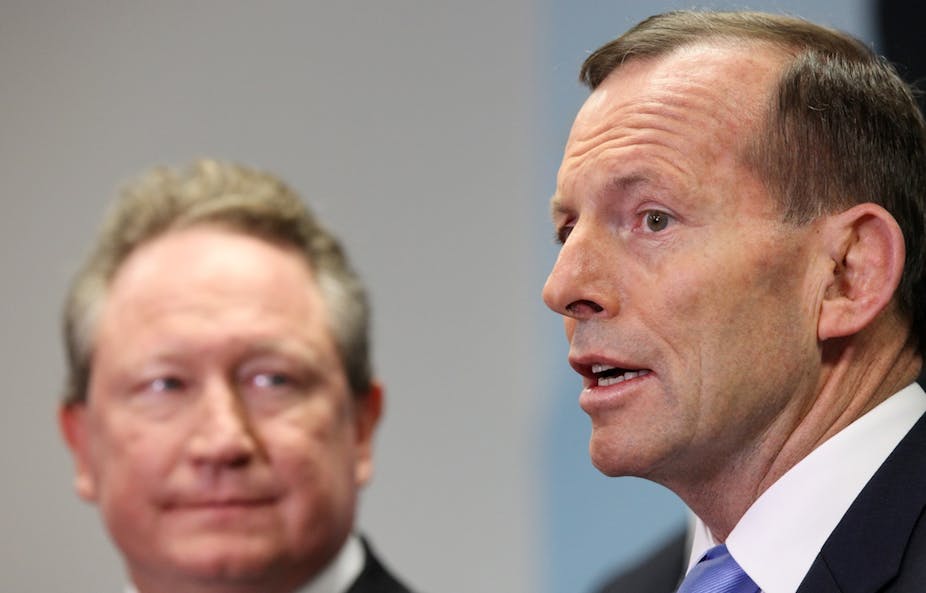In the wake of a falling iron ore price that has cut his personal fortune by more than A$2 billion, Andrew Forrest has remained unperturbed, saying: “I didn’t count on the way up, and I’m not counting now”. If only Joe Hockey could say the same thing.
Unfortunately for Hockey, the Coalition and the Australian public, previous governments did count on the way up, and that will force all of us to count on the way down. As iron ore prices, the terms of trade and hence tax collections rose, government spending under the Rudd-Gillard-Swan regime ballooned.
If that all sounds pretty predictable, there’s one important detail that might surprise you. According to the report released Wednesday by the non-partisan Parliamentary Budget Office, the biggest swing factor in the budgetary outlook is not the terms of trade, but labour productivity. And it is arguably the factor that’s hardest to predict.
First: the budget bottom line. The PBO predicts the budget back in the black in 2018-19 and generating a surplus of 1.4% of GDP in 2024-25. Along with that, net debt — the amount the government owes minus what is owed to it — is projected to fall from 13.9% of GDP in 2014–15 to 0.7% of GDP in 2024–25.
Taken at face value this is rather reassuring. No big dramas, no big blowouts. Sure we run deficits for a few more years but net debt stays very low by historical standards and is essentially zero a decade from now.
But it is in the wonk paradise that lurks beneath those bottom-line numbers where the real story lies.
What will really affect the deficit
The PBO report points to three main factors that affect projected deficits or surpluses: labour participation (how many people over the age of 15 work), labour productivity (how much output labour creates per hour) and the terms of trade (the prices we get for our exports relative to the prices we pay for our imports).
The PBO base case assumes labour productivity grows at its historical average rate of 1.5% per annum. But it was slower than this in the 1980s and the 2000s – with the exception being the 1990s, which witnessed a massive information technology revolution.
A half-percentage-point bump in labour productivity growth about the historical average would add 1.1% to the 2024-25 surplus, but the mirror opposite is basically true if it is slower. This is a big range of possible outcomes and — as the report itself says — the risk appears to be more on the downside than the upside.
On the other hand, a 10% movement in the terms of trade has a 0.5% impact on the budget bottom line in 2024-25. This is not small, but it is basically a $10 billion annual reduction in receipts by 2024-25 — $7.9 billion due to lower company tax receipts from mining companies.
What the report doesn’t emphasise is that a big part of what keeps revenues growing in those projections is bracket creep — the unsavoury and uneconomic fact that the thresholds for increased personal income tax rates are stuck in nominal terms. (Independent Economics, which provides the macroeconomic model the PBO uses, discusses this on its website.) So as time passes and incomes grow, so do the number of people who pay very high marginal tax rates.
Tax crunch
There’s a political problem with this. It isn’t sustainable to have a huge chunk of the population paying the highest marginal tax rate, so something will have to give politically. Moreover, personal income taxes are among the most distorting and inefficient taxes — they negatively change how much people work by quite a lot relative to how much revenue they raise.
In that sense, the PBO report, which understandably assumes no policy adjustments, paints too rosy a picture of revenue growth. And that gets us to the heart of the budgetary issue.
The celebrated economist John Maynard Keynes famously said “in the long run we are all dead”. Well yes, that’s true. But it doesn’t mean we shouldn’t worry about the long run. As a very fine mathematician himself, Keynes might equally have observed that 1.01100=2.7. Put differently, a 1% gap between taxes and outlays, every year for a century, leads to outlays being 2.7 times as large as taxes.
Temporary shocks to government revenues, or outlays, don’t compound. Structural increases in spending do. That’s why I (and most other numerate commentators) have repeatedly said we don’t have a “budget crisis” and we certainly don’t have a debt crisis.
What we do have is a host of spending commitments that are likely to grow faster than tax revenues. And when you compound those for long enough then, as they say in show business: “Boom goes the dynamite!”
Debt debate
For all the flack he’s copped, Joe Hockey clearly gets this. That’s why he has emphasised aged pension reform and indexation of petrol excise. OK, his execution could have been better, but partial credit where partial credit is due.
And it’s worth noting that this lies in stark contrast to the current prime minister who repeatedly goes on about the (tiny) amount the government pays in interest on the (very small) debt it has. One of the PM’s advisers with business experience needs to tell him that debt is not immoral. And that when you can get a bigger return on investment than the cost in interest — like on important infrastructure spending — debt is a good thing.
Household finances may well be about credit card debt and mortgage payments — but government finances are just not.
The PBO report reminds us of this difference in viewpoints. It reminds us that structural problems require structural solutions, and that Australia has time to implement them. But if we don’t have the political will or efficacy to do so, then one day we really will have a budget crisis.

